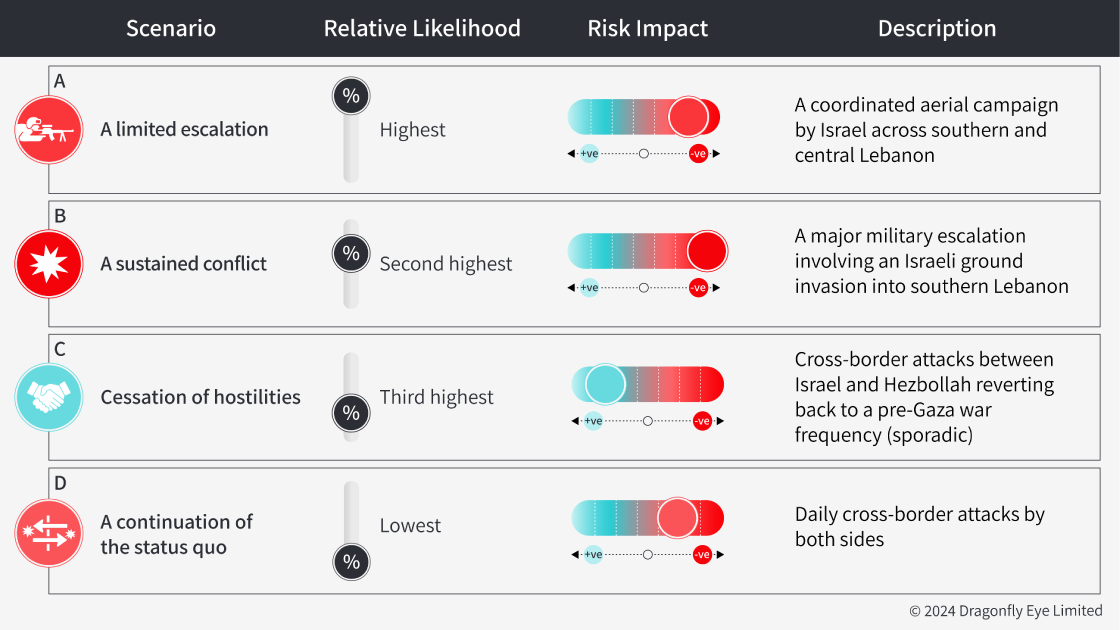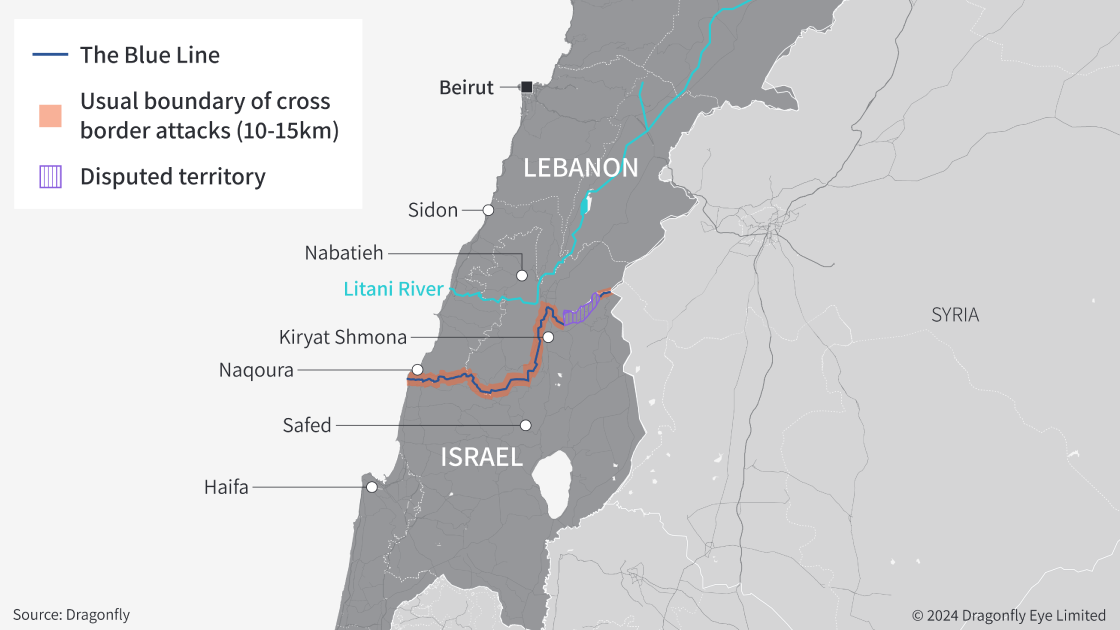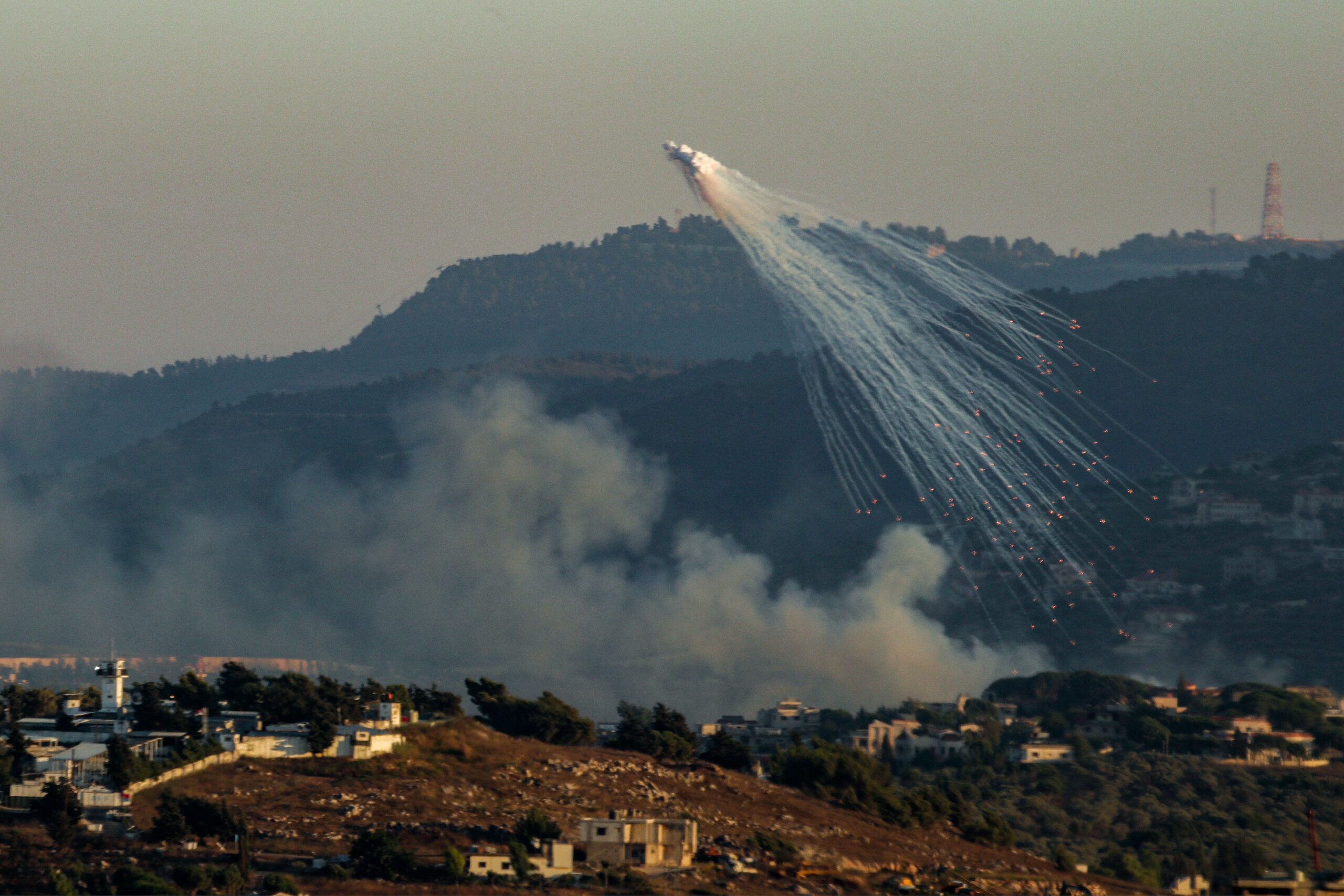A major escalation between Israel and Hezbollah is reasonably likely in the next three months
This assessment was issued to clients of Dragonfly’s Security Intelligence & Analysis Service (SIAS) on 15 July 2024.
- Hezbollah attacks in the past week have killed Israeli civilians after Israel assassinated two senior Hezbollah commanders
- In that event, Israel would probably conduct a coordinated aerial campaign across southern and central Lebanon
We still assess that a coordinated aerial campaign between Israel and Hezbollah in Lebanon is reasonably possible in the next three months. The situation along the border seems intolerable for the Israeli government. Hezbollah says it will not stop daily drone and missile attacks into northern Israel until there is a lasting ceasefire in Gaza. Not only is a lasting ceasefire in Gaza unlikely, but in any case we doubt that the situation on the northern border would stabilise as a result. Israel is near-certain to not accept Hezbollah being heavily armed so close to the border.
Armed hostilities and rhetoric between the two sides seem to be escalating ever-faster than previously in recent weeks. Israel says it has plans readying it for an ‘all-out war’, and two (out of at least four) of the most senior Hezbollah commanders assassinated by Israel in Lebanon and Syria since October last year have been in the past two weeks. Hezbollah meanwhile has on several occasions launched over 200 projectiles in single operations against Israel. And with the Israeli government vulnerable to collapse in the coming months, far-right members seem to be pressuring the prime minister to take action against Hezbollah, while they still have the political authority to do so.
In light of this, we have conducted a near-term (three months) scenario analysis for the border situation.
The most likely scenario in the next three months
The most likely scenario along the border to unfold in the next three months is a coordinated aerial campaign by Israel in southern and central Lebanon (including the Bekaa). The fragility of the Israeli government appears to be weighing against the prospects of an uncontrolled major conflict during this time frame. But it also seems to be motivating the far-right government to try and embark on a limited escalation sooner. In our analysis, this is because once a major escalation is underway, there will be little political appetite to unseat the government, at least until the operation is completed.

The main consequences of this would very probably be:
- Israel: brief airspace closures and re-routing of civil aviation
- Israel: Haifa and areas north of the city (including the Golan Heights in the east) becoming very dangerous for residents and travellers
- Lebanon: prolonged airspace closure
- Lebanon: areas south of Sidon (particularly south of the Litani River), and the Bekaa Valley, becoming the main locations of the conflict. We also anticipate the Hezbollah strongholds in southern Beirut would be targeted by Israeli strikes
An Israeli ground campaign is unlikely in the coming months. But a Hezbollah attack resulting in mass civilian casualties (dozens) would make that scenario probable, if not serve as a precursor for it. And signs that this is imminent would be Israel issuing Hezbollah an ultimatum to withdraw to the north of the Litani River, and the Israeli military recalling reservists as well as building field hospitals, storage facilities and observation towers along the border. The Litani River is the border of the UN-agreed buffer zone between Lebanon and Israel following the 2006 conflict.
We encourage the reading and sharing of our crisis planning report for Lebanon. This was originally published in 2023 but options for evacuation and other aspects of crisis response remain the same.
Israel highly intent on degrading Hezbollah this year
Israel is unlikely to accept Hezbollah drone and missile launch positions manned and activated so close to the border for much longer. Hezbollah leader, Hassan Nasrallah, has signalled in his recent speeches that the group will not retreat north of the Litani River any time soon, and specifically not before a sustained ceasefire in Gaza that results in Israel’s military withdrawing from the strip. But with Israeli hostages still unaccounted for in Gaza and no concrete proposals for security in Gaza post-conflict, we highly doubt the Israeli military will leave in the coming months.
Israeli government rhetoric has so far fallen short of giving Hezbollah an ultimatum or significantly expanding military operations in southern Lebanon. But it seems to be assassinating more senior Hezbollah commanders than before. Those operations are in line with Israel’s longer-term objectives of confronting the threat from Hezbollah beyond the current conflict. The Israeli government has also reportedly approved unspecified plans for an ‘all-out war’ with Hezbollah.

The Israeli military is reasonably likely to launch a weeks-long coordinated aerial campaign across southern and central Lebanon. The aim of this would be to degrade Hezbollah, in particular south of the Litani River (see map), and push its missile and drone units north of the river. This is because Hezbollah has been able to mount daily short-range rocket and mortar attacks from positions in southern Lebanon. Those have necessitated the relocation of civilians out of northern Israel.
Israel would also target senior Hezbollah commanders, command centres and weapons depots across southern Lebanon, Bekaa Valley and southern Beirut. That is with the objective of diminishing the groups’ short (and medium-range) capabilities. In response, we assess that Hezbollah would very probably launch at least a few thousand rockets a day towards northern Israel. According to US and Israeli military intelligence estimates from two years ago, Hezbollah had at least a 100,000 rockets in its arsenal. This includes long-range precision missiles that can reach Tel Aviv and Haifa, meaning periodic airspace closures and disruptions to civil aviation in Israel would be very likely.
Pro-Iran groups in Syria and Iraq would probably also launch attacks into northeastern Israel. This would be to stretch Israeli air defences. We have strong confidence that Israeli air defences would not fail as a result of these attacks. Their efficacy is usually above 90%, but it is plausible that many projectiles a day would breach Israeli air defences if faced with several thousand drone and missile attacks a day. This would expose civilian centres to attacks. And in turn prompt further Israeli retaliation and so military escalation.
We still assess that an Israeli ground invasion into southern Lebanon is unlikely in 2024. This is largely because such action would almost certainly stretch a battle-fatigued Israeli military after nine months of war in Gaza – concerns about which commanders in Gaza have raised publicly. But also because a ground invasion would prompt a greater reaction from pro-Iran groups in Syria, Iraq and Yemen, and increase the currently moderate chances of further direct attacks from Iran, risking a regional war.
We also doubt the Israeli government would have the support of the Israeli and US military and intelligence establishment for such an escalation. Nor would there be much diplomatic support from the US and Europe for troops on the ground inside Lebanon.
Hezbollah continues to signal aversion to war
Outside of a wider escalation, a Hezbollah attack on a major city or town is highly unlikely in the next three months. The group continues to signal its willingness to sustain its cross-border attacks and even expand them by recently using heavier weapons and striking deeper inside Israel than before. But we have also not seen anything to suggest the group or Iran, Hezbollah’s main backer, is intent on attacking a city. Iran probably views Hezbollah as too valuable to risk being significantly degraded in a conflict with Israel at present.
Drivers for deeper conflict appear to be worsening
We have identified two key determinants for the trajectory of a conflict between Israel and Hezbollah until September: the survival of the current Israeli government and the prospects of a ceasefire in Gaza. Both have the potential to significantly affect the course of cross-border hostilities. This is mainly because the current Israeli government is now reliant on far-right extremists who seem to be pushing for greater action in Gaza and Lebanon sooner, before the government collapses. We view this as likely by the end of the year. A ceasefire in Gaza seems to be the clearest off-ramp for Hezbollah.
Based on these key factors and estimates, we have outlined four mutually exclusive scenarios to support planning for the next three months. The most likely of those is a limited escalation (aerial campaign) during this time frame. A sustained conflict or a cessation of hostilities are second and third most likely scenarios. However, the difference in probability between these is marginal, in our assessment. The least likely of these is the continuation of daily cross-border attacks at current levels.
Scenario A: Limited escalation
Most likely scenario (40%)
The Israeli prime minister heeds to calls by extremists in his government to escalate military action against Hezbollah. This prompts a major aerial campaign across southern and central Lebanon with the aim of pushing Hezbollah back north of the Litani River to allow the safe return of displaced Israelis to northern communities. This would result in Hezbollah responding with at least a few thousand missile and drone attacks a day against towns and cities including Haifa and Tel Aviv. Such an operation would probably last several weeks at least, and involve pro-Iran groups in Syria and Iraq intensifying their rocket attacks against Israel during this period.
This scenario would have the following implications:
- Conflict between Israel and Hezbollah deepens, with Israel hitting a wide range of Hezbollah targets across central Lebanon, including in southern Beirut
- Prolonged airspace closure in Lebanon, and periodic closures in Israel
- Pro-Iran groups in the region (Syria, Iraq, Yemen) increase the frequency of their attacks on Israel and US interests from monthly to weekly
- Hezbollah begins to target civilian centres in north and central Israel
- Displaced Israeli communities in the north not able to immediately return home
- Foreign governments begin to evacuate citizens from Lebanon
- The Lebanese government would seek international mediation efforts to deescalate
- The terrorism threat remains elevated, between high and severe in Israel and Lebanon
Indicators this scenario is becoming less likely:
- The Israeli government collapses
- Hezbollah leader suggests the group would comply with any truce agreement in Gaza, even if it is not a lasting one
- European countries, namely France, submit formal proposals for de-escalation to Israel and Lebanon
- Israel rescues more hostages through military operations in Gaza
Points of no return
- The Israeli government issues an ultimatum to Hezbollah demanding the end of hostilities in a specific period of time
- The Israeli government issues stay-at-home orders for communities living within 10 to 30km from the border with Lebanon
These are developments that we assess would make other scenarios only a remote possibility.
Scenario B: Sustained conflict
Second most probable scenario (25%)
Hezbollah mounts an attack in northern Israel that kills several civilians. Renewed political support off the back of that prompts the Israeli government to double down on its threats to take greater action against Hezbollah. This would not only be a means to secure its northern communities, but also to degrade the group to the point it is unable to launch attacks at the same pace and intensity since October last year. It pursues a ground invasion, like in the 2006 conflict, in which the Israeli military seeks to create a buffer zone by occupying southern Lebanese territory.
It is possible, if not probable, that our first scenario (a coordinated Israeli aerial campaign) would also lead to a ground invasion if Israel is unable to achieve its objective of pushing Hezbollah further north. In any case, we assess that this would take several months, and so is highly unlikely to happen in the three-month outlook. A ground invasion would have a high potential to last several years (albeit at varying intensities) given Hezbollah’s ability to sustain a long ground conflict. That is for example using its recent experience in fighting in Syria and significantly improved capabilities over the past two decades.
This scenario will have the following implications:
- Mass internal evacuations of large parts of southern and central Lebanon. And further, but more limited, evacuations from northern Israeli towns and cities
- Prolonged closures of Israeli and Lebanese airspace
- Pro-Iran groups in the region (Syria, Iraq, Yemen) increase the frequency of their attacks on Israel and the US from monthly to weekly
- Direct Iranian attacks against Israel would become highly likely during the operation
- A risk of a major regional war would become very high, especially if Hezbollah is on the verge of being defeated
Indicators this scenario is becoming more likely:
- The Israeli authorities issue an ultimatum to start a sustained ground operation against Hezbollah unless the group starts to disarm of all its forces south of the Litani River
- Israel intensifies already-weekly attacks against critical militia supply routes in Syria that Hezbollah use for replenishing weapons and fighters
- The Israeli authorities cut diplomatic ties with several countries, including allies, over disagreements related to its military actions against Hezbollah and Hamas
- New Israeli elections result in a far-right government that calls for a major conflict with Hezbollah
Points of no return
- The Israeli government moves the bulk of its combat troops towards the north
- The Israeli government recalls all reservists
These are developments that we assess would make other scenarios only a remote possibility.
Scenario C: Cessation of hostilities (20%)
Third most likely scenario (20%)
The Israeli government collapses in the coming weeks, deferring Israel’s intent to escalate tensions. New elections prompt the Israeli government to seek political solutions to the conflict with Hezbollah, at least for now. This includes attempts to revive the UN resolution that ended the 2006 war, which involved Hezbollah retreating from southern Lebanon and Lebanese and peacekeeping forces expanding their operations there. But even in this scenario, any deescalation would probably be temporary. And any new government in Israel would quickly refocus on confronting Hezbollah within the next five years.
This scenario will have the following implications:
- A full-fledged regional war becomes unlikely
- Cross-border attacks between Israel and Hezbollah would end and revert back to a pre-Gaza war frequency, occurring sporadically
- Israel communities would return to the north
Indicators this scenario is becoming more likely:
- The Israeli government collapses and a centrist government under the promise of finding political solutions to conflicts is elected
- European countries, namely France, submit formal proposals for deescalation to Israel and Lebanon
- A comprehensive ceasefire is agreed in Gaza
- Hezbollah strongly signals it will comply with a ceasefire in Gaza
Points of no return
- A lasting ceasefire is agreed in Gaza between Israel and Hamas
- Hezbollah and Israel reach an agreement to solve their dispute diplomatically
These are developments that we assess would make other scenarios only a remote possibility.
Scenario D: Continuation of the status quo
Least likely scenario (15%)
The continuation of the status quo is a primary reason why escalation appears reasonably likely. This is both intended and unintended escalations. The daily occurrence of cross-border attacks seems intolerable for Israel, and these also carry with them the high risk of miscalculation or accident from both sides.
Methodolgy
The methodology used in this scenario analysis entails a structured analytical approach in which we identify and validate assumptions, and determine and map the key drivers, indicators and uncertainties to model probabilities.
Our method combines both qualitative and quantitative inputs, so we indicate any probabilities of each scenario as approximates, emphasising which scenario is the most likely. If you have questions please get in touch.
Image: Smoke from Israeli bombardment billows amid ongoing cross-border tensions as fighting continues between Israel and Hamas in the Gaza Strip in Kfarkila, Lebanonon, on 12 July 2024. Photo by Rabih Daher/AFP via Getty Images.




